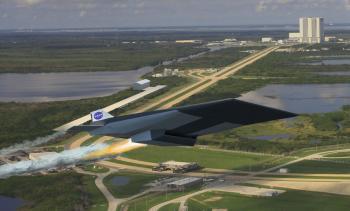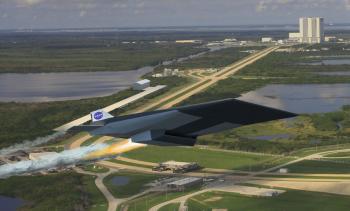Ways to push existing technologies for a new system of space travel are being examined by engineers at NASA’s Kennedy Space Center. An early proposal suggests using a wedge-shaped aircraft with scramjets that would be horizontally launched from a track.
While the Advanced Space Launch System is still in the preliminary stages, engineers believe that a working system could be created within the next 10 years.
The proposal describes a craft that would launch from a two-mile-long, electrified or gas-powered track, and fly into the upper atmosphere up to a speed of Mach 10. A small capsule would then shoot the vehicle into orbit, similar to a second stage from a conventional rocket. On the return trip, the craft would land on a runway as would an airplane.
Although it sounds like science fiction, engineers say such a system can be accomplished without inventing new technology. According to NASA the Advanced Space Launch System would require several advances in existing technologies, however, but they argue that the work would contribute to various aspects of the nation’s high-tech industry.
The proposal for the system’s rail launcher is not unlike the electric tracks used for rollercoasters. While significant improvements would have to be made in order to make a track that could send a vehicle into space, NASA has already created small-scale tracks at the agency’s Marshall Space Flight Center in Huntsville, Alabama, and at the Kennedy Space Center.
Engineers say that innovations created while building the launching track could also lead to improvements in Earth-bound projects such as commuter rail systems.
While the Advanced Space Launch System is still in the preliminary stages, engineers believe that a working system could be created within the next 10 years.
The proposal describes a craft that would launch from a two-mile-long, electrified or gas-powered track, and fly into the upper atmosphere up to a speed of Mach 10. A small capsule would then shoot the vehicle into orbit, similar to a second stage from a conventional rocket. On the return trip, the craft would land on a runway as would an airplane.
Although it sounds like science fiction, engineers say such a system can be accomplished without inventing new technology. According to NASA the Advanced Space Launch System would require several advances in existing technologies, however, but they argue that the work would contribute to various aspects of the nation’s high-tech industry.
The proposal for the system’s rail launcher is not unlike the electric tracks used for rollercoasters. While significant improvements would have to be made in order to make a track that could send a vehicle into space, NASA has already created small-scale tracks at the agency’s Marshall Space Flight Center in Huntsville, Alabama, and at the Kennedy Space Center.
Engineers say that innovations created while building the launching track could also lead to improvements in Earth-bound projects such as commuter rail systems.







